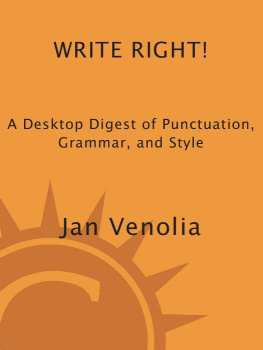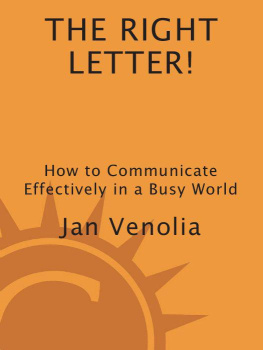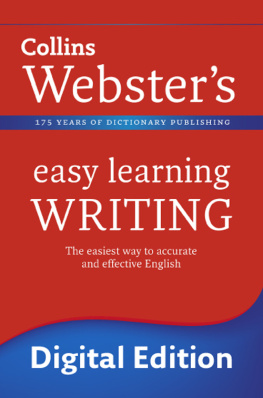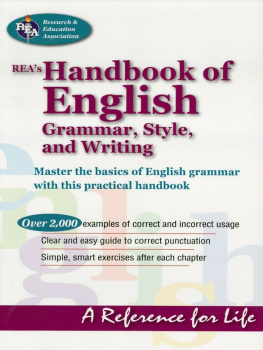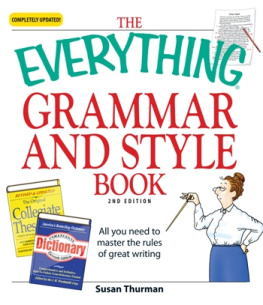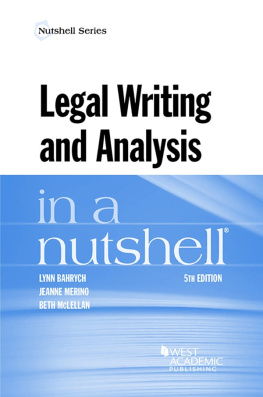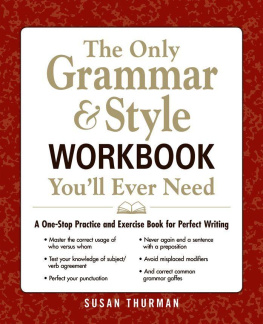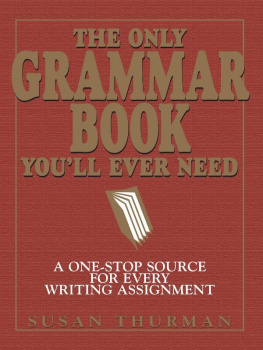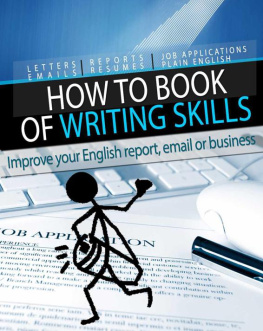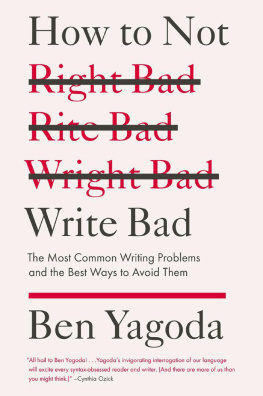Copyright 1979, 1980, 1982, 1988, 1995, 2001 by Janet G. Venolia
All rights reserved.
Published in the United States by Ten Speed Press, an imprint of the Crown Publishing Group, a division of Random House, Inc., New York.
www.crownpublishing.com
www.tenspeed.com
Ten Speed Press and the Ten Speed Press colophon are registered trademarks of Random House, Inc.
Library of Congress Cataloging-in-Publication Data
Venolia, Jan.
Write right! : a desktop digest of punctuation, grammar, and style / Jan Venolia.4th ed.
p. cm.
1. English languageGrammarHandbooks, manuals, etc. 2. English languagePunctuationHandbooks, manuals, etc. 3. English languageStyleHandbooks, manuals, etc. I. Title.
PE1112.V4 2001
428.2dc21
2001003524
eISBN: 978-0-307-78418-6
Copyediting by Suzanne Byerley
Illustrations by Ellen Sasaki
v3.1
Words are the only tools you will be given. Learn to use them with originality and care. Value them for their strength and diversity. And also remember that somebody out there is listening.
William Zinsser
Amen.
Jan Venolia


Writing is easy. All you have to do is cross out the wrong words.
Mark Twain

Why All the Fuss?
Our language is an invaluable resource, as much a part of our heritage as forests, wildlife, and waters.Paul Lovinger
Does good writing matter any more? In an e-commerce environment, do you still need to know how to create an effective sentence? Absolutely! Magazines, newspapers, and books are written words, whether in electronic or print form. What emerges from fax machines and appears on computer screens is writing, not speech. Businesses still need to put it in writing. Furthermore, whats written needs to be clear and concise. Thats where punctuation and grammar come in.
On the job or at school, you probably have to writefast and well. You need to know how to choose the words that best convey your ideas and how to organize them for maximum effect. Can you rely on software to improve your writing? It helps. You can easily revise text, experiment with format, and find typos (though spell-checkers have definite limitations). But grammar-checkers are more annoying than useful. A concise handbook like Write Right! remains your best bet.
But what is good writing? And who says so? Who decides which changes in language are acceptable and which are to be rejected? Described as usage wars, this subject is hotly debated in language and education circles.
On one side, the combatants declare that what constitutes good English should not be determined by arbitrary and archaic rules but by how the language has evolved. They cite the living nature of language to justify accepting change of all kinds. They study everyday speech and writing, and what they determine to be the norms are then deemed acceptable. Anyone who disagrees is considered to be elitist.
Trying to hold the line against this anything goes approach are those who believe that effective communication adheres to certain rules. Those rules make it more likely that written words will be understood. Clear writing is not seen as archaic but just good policy.
By now, you have probably deduced which side Im on in these language wars. I, in turn, am able to make some assumptions about you. You are reading these lines, so I presume you want sound guidance in the matter of writing well.
I will not advise you that the language you hear on the street or even on the evening news is what you should emulate. Instead, I will draw upon judgments accumulated over decades of writing, of reading, and of studying the rules of clear and effective writing.
My judgments are grounded in the belief that making the readers job easier is in the interests of reader and writer alike.
By making the readers job easier, you show respect. You show consideration. At the same time, you improve the odds of being understood and thus of communicating what you want to communicate. True, an ill-formed, confusing sentence can usually be teased apart and understoodeventually. But why waste the readers time trying to guess what you mean? Clarity and precision are always desirable.
Be forewarned, while youre improving your writing, I want you to rediscover the English language and rally to its defense. Its richness and variety are under siege. When disinterested becomes synonymous with uninterested and dilemma with predicament, we lose important tools for expressing ourselves. If wrong words proliferate, then hone replaces home, staunch crowds out stanch, and we encounter hybrids like doubtlessly, a kissing cousin of the redundant irregardless. Theodore Bernstein, author of The Careful Writer, suggests that accepting this degradation of language is the equivalent of declaring a crime legal when it has been committed often enough.
Concerned about this loss of richness in our language, Ive expanded the sections on usage and style in Write Right! Alas, many of the examples of errors that Ive included come from magazines, newspapers, and even bookspublications that had been read by someone who was paid to catch such errors. Even so, the best antidote for the epidemic of wrong words is to read widely but with an informed eye. I propose to help you become informed.
Write Right! covers the common errors writers make in punctuation and grammar. Avoiding those errors means youre off to a good start. But lifeless prose and sloppy usage are greater threats to good writing than misuse of an apostrophe, so the rest of the book addresses those problems as well.
P ART O NE , The Basics, provides a review of grammatical terms. Though not ends in themselves, the terms do help you understand the rules Ive included in this book. , Coming to Terms with Terms, defines the eight parts of speech and describes the elements that make up sentences. It goes into additional detail for the two trickiest parts of speech, verbs and pronouns.
P ART Two, The Tools of Writing, covers grammar, punctuation, and copyediting. Refer to , Copyediting Considerations, helps you add a professional gloss in such matters as capitalization, italics, and treatment of numbers.
P ART T HREE , The Craft of Writing, considers the final product. , Style, helps you root out ho-hum writing. After all, a sentence can be grammatically correct, properly punctuated, and still be tedious. You want to invigorate your writing as well.
The final section in the book, Resources, includes a glossary, bibliography, list of frequently misspelled words, and the addresses of some interesting Web sites.
As in previous editions of Write Right!, the rules are illustrated with quotations that were chosen to edify and amuse. Throughout, Ellen Sasakis whimsical drawings keep us from taking ourselves, and our rules, too seriously.
Write Right! answers the questions about writing that come up most often in your work or studies. Keep it next to your keyboard or tucked in a desk drawer for ready reference. If you need help with a more advanced level of revising, refer to

